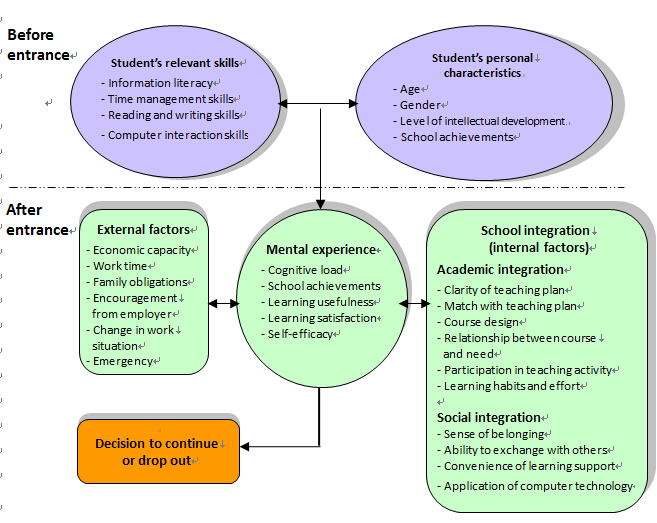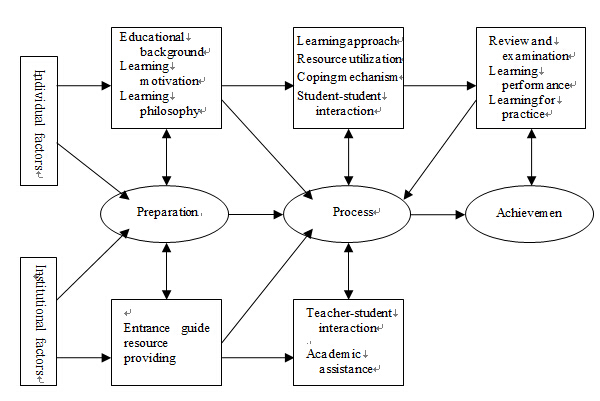IV. Research conclusion and discussion
By referring to the five core questions raised by Simpson, this research has established the following preliminary conclusions.
1. What is the dropout rate in open and distance education?
The dropout rate from open and distance education was calculated based on the Basic Information Database on School Enrollment Status (1999-2009). From 1999-2009, the dropout rate for the junior college programme was 14.20%, while for the undergraduate programme it was10.65%, averaging 12.85%. Dropout rates vary between study levels and majors. In the junior college programme, the three majors topping the dropout list were English, Computer Science and Numerical Control Technology, whose dropout rates were 37.21%,21.06% and 20.13% respectively. In the undergraduate programme, the three majors topping the dropout list were English, Computer Science and Business Administration, whose dropout rates were 19.69%, 16.81% and 16.35% respectively. Seen from a sequential time perspective, dropout rates at the provincial RTVU are obviously declining (Zhu Zulin, 2011).
2.What is the temporal regularity of dropout rates?
The project’s prospective exploratory shows the temporal regularity of dropout rates. An analysis was made of 1196 Computer Science major dropouts from Tianjin RTVU from 1999-2008. It reveals that the peak dropout periods are the second semester, the first semester, at registration, and the third semester. Dropouts in these four periods account for 87% of the total, and those in the first two periods account for nearly 70%. Thus it can be seen that the highest dropout rates appear in the first school year (Li Ying, 2009).
The above findings are further evidenced by a follow-up study of three continuous semesters of English majors. Among the 398 dropouts (of 2237 students), the dropout rates for the first, second and third semesters stand at 9.1%, 8.0% and 0.6% respectively.
3. What are the reasons for dropouts?
Both the quantitative and qualitative studies reveal the reasons for dropouts from different perspectives.
Based on the Basic Information Database on School Enrollment Status (1999-2009), data mining, grey relational analysis, survival analysis and other approaches were used. The findings show that the gender and age of the learner, the administrative zone where the learning centre is located, the study level, major, and academic record of the learner are all factors influencing dropout rates (Zhu Zulin, 2011; Li Ying, 2014).
Findings from the Research Database on English Major Dropouts show that the major reasons for dropouts are work-study conflict; wrong or inappropriate choice of major; learning difficulty; lack of effective learning methods; life or work emergency; short of learning motivation; weak emotional relationships; socio-economic disadvantage; inconvenient transportation arrangement; and inadequate learning support (Du Yongxin, 2011; Yang Yongjian,2011a;Luo Hongwei, 2011; Qi Yansheng, 2011; Liu Yongquan, 2011; Guo Hongxia, 2011; Rong Huali, 2011; Chen Jie; Chen Henan, 2012; Sun Xiaoling, 2012; Li Ying, 2011).The Explanatory Framework for Open and Distance Education Dropout Rates was formulated by sorting through the research findings of Rovia, A.P.(2003) and Park, J.-H.(2009) (Du Yongxin, 2011). Figure 2 further reveals the relationship between different parts of the complex distance education dropout phenomena, that is, the function mechanism and dropout mechanism behind the reasons students dropout. Before entrance, the students are not fully equipped with the relevant capabilities, including information literacy, time management skills, English reading and writing skills, and computer interaction skills. After entrance, their sustained learning is affected by a mismatch between their learning ability and the teaching plan or teaching requirements, a lack of teacher-student interaction, and learning motivation, as well as external factors such as work and everyday life. As a result, they have a negative mental experience and give up learning because of their unsatisfactory learning achievements, low pass rate, and loss of confidence (Li Ying, 2013). The Explanatory Framework for Open and Distance Education Dropout Rates also reveals that learning support services provided by distance education universities also greatly influence the mental experience of learners at school and their decision to drop out.
Figure 2 Explanatory Framework for Open and Distance Education Dropout Rates
(Developed based on figures produced by Rovai (2003) and Park (2009))
A further in-depth exploration was made into how certain factors function within the Explanatory Framework.
Based on the course registration and academic achievements of undergraduate English major dropouts across three semesters, the impact of course choice on academic achievement and dropout rates were analyzed in the “Report on the Course Registration and Academic Achievements of Undergraduate Dropouts”. In the first semester, learners with weak specialized foundation knowledge tend to choose more specialized courses without having a full understanding of the difficulty of the course, and some even register for specialized courses in successive semesters ahead of time. Since they are overloaded with too many difficult courses, it is easy for the students to fall behind and thus drop out. In the second semester, some learners remain despite early setbacks. As the difficulty of the courses increase, it is necessary for the students to change or reduce the number of specialized courses they are taking, otherwise the rate of failure continues to increase, leading them to drop out in the second semester. By the third semester, students may continue despite unsatisfactory course results, but the overall trend of failure cannot be reversed and an eventual loss of confidence will cause the students to drop out (Li Ying, 2012).
Within the framework of self-determination theory, the focus of “Study on the Learning Motivation of Undergraduate English Major Dropouts in Open and Distance Education” is to analyze the relationship between motivation and learning behavior as part of the learning process, and explore the influence of learning motivation on dropout rates. The findings are as follows. When they first enter the school, learners are highly motivated and are confident they will complete their learning. During the course of learning, learners discover that there is a gap between their own learning ability and professional learning. They feel frustrated and their learning motivation declines sharply. As a result, face-to-face tutorials, online teaching and other learning support services may have greater influence over their learning motivation. They may sometimes become more important factors causing dropouts (Zhang Ping, 2012).
Based on both interviews with excellent learners and qualitative analysis, the paper has constructed a mechanism of the major factors affecting whether or not students finish their studies. The 14 major factors affecting learning outcomes are: educational background, learning motivation, learning philosophy, learning approach, resource utilization, coping mechanism, student-student interaction, review and examination, learning performance, learning for practice, entrance guidance, resource provision, teacher-student interaction, and academic assistance. The first 10 items can be classified as individual factors and the last four items institutional factors. They function jointly across the three periods of learning: preparation, process and achievement. Learning achievement requires a good educational background, clear learning motivation, flexible learning strategies and all-round learning support. See Figure 3 (Yang Yongjian, 2011b).
Figure 3 Diagram of the Relationship Between Essential Factors for Learning Outcomes
4. What types of students tend to drop out?
By combining the investigative and research findings of the project, the study proposes that learners who have weak distance education learning skills (information literacy, time management ability, teacher-student interaction);who have chosen the wrong major or inappropriate study level; who are overloaded; who have failed a number of courses; who lack driving force; who lack determination; or who are economically disadvantaged are more inclined to drop out.